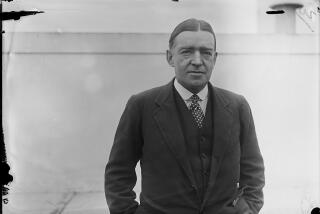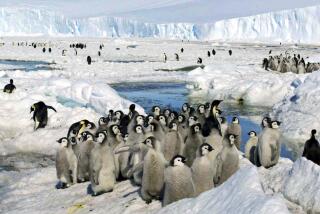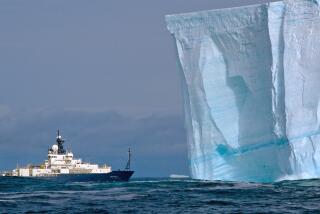Scientists Finish Their Antarctic Journey
- Share via
Facing bitter cold, yawning crevasses and whiteout blizzard conditions, a team of scientists has successfully retraced the steps of ill-fated explorer Robert Falcon Scott to the South Pole, crossing 776 miles of unforgiving Antarctic territory.
Setting out Nov. 23 on its journey to better understand the climate of the remote, frozen continent, the team made its first discovery after being forced back to base camp after just 48 hours. There was so much soft, deep snow that the heaviest sled kept sinking, something that had never happened on shorter traverses taken over the last four years.
The unusually heavy blanket of snow was, the scientists now believe, the result of the long reach of this winter’s El Nino.
“El Nino was thought, a decade ago, to be only a tropical phenomenon,” Paul Mayewski, the leader of the International Trans Antarctic Science Expedition, said Monday during a news conference transmitted via satellite from the South Pole.
The new findings, if they are verified, suggest that El Nino is truly global in scope, and “makes understanding it even more important,” said Mayewski, an ice chemist from the University of Maine.
While the ill-equipped Scott and his men ended up pulling their own sleds across the ice during their fatal 1912 push to the pole, the Mayewski team members traveled in relative comfort. Their sleds, loaded with 50,000 pounds of food, fuel, three heated buildings and one outhouse for the monthlong journey, were hauled by tractors. They also had satellite phones.
So, when their sleds sank, the scientists called for pontoon-shaped sleds mounted on wider runners, said Paul Hess, the expedition mechanic. The New York Air National Guard delivered the goods by ski-equipped C-130 aircraft in a few days and the team of 10 men and three women was off again Dec. 7.
They did well with the new gear. On some legs, they traveled 125 miles in what they called one “day.” The term day is somewhat meaningless in summer near the South Pole, where it is light around the clock because the sun never sets. The team would typically travel for 36 to 60 hours, averaging about 5 mph, before stopping to drill into the ice for samples or probe its underbelly with radar.
“We want to change Antarctica from one of the most poorly understood regions of the Earth in terms of climate to one of the best,” Mayewski said. Antarctica is perplexing to climatologists because the western part is warming in response to long-term climate signals like the end of the last Ice Age and possibly to human-induced global warming, but the eastern part is defying the trend of the rest of the planet and cooling.
The miles-thick accumulation of ice has also preserved a nearly perfect record of the Earth’s history. It includes fine, bluish layers of each season’s snowfall, bubbles of gas that capture the composition of past atmospheres and thin layers of volcanic ash, wind-transported sea salt and traces of industrial pollutants.
“They’re just absolutely beautiful signals,” Mayewski said.
Mayewski’s team is the second American expedition to reach the pole by ground. A naval expedition made the trip in 1961. Scott, a British explorer, hoped to be the first to set foot on the pole. He reached it on Jan. 17, 1912, only to discover that he was beaten by Norwegian explorer Roald Amundsen, who led a smaller and more efficient expedition. Scott’s diary entry for the day reads: “The Pole. Yes, but under very different circumstances from those expected. We have had a horrible day ... “
Scott and his four-man party died on their way back. In the end, Scott was just 11 miles from a food depot, but trapped in his tent by a blizzard.
Scott was a figure the team thought of often. “When you step outside of the vehicle you’d definitely get a feeling for the isolation and penetrating cold and how lonely you’d be without all the support we had,” Mayewski said.
The most frightening moment for the modern trekkers was a blizzard that hit when they were 600 miles from the pole, pummeling them with 40-mph winds and leaving them in a pure whiteout. “All we could do was sit and wait and see how deeply it would bury us,” said Dan Dixon, a University of Maine graduate student.
They emerged and reached South Pole Station on Thursday. The distant continent is turning out to be a crucial natural laboratory. “We look at Antarctica as one of the last bastions of a natural atmosphere and are trying to see how much it’s changed,” Mayewski said. In addition to looking for the effects of global warming on the ice cap, he is eager to see whether the ice will show traces of lead and acid rain as it has in Greenland.
“If we start seeing this in Antarctica, it would be indicative of a very congested atmosphere,” he said.
The international team plans to continue its trek around the continent’s Ross Sea in future years. For now, Mayewski is content to spend time analyzing the hundreds of ice cores and samples his team drilled out of the ice. In addition to understanding how the climate has changed, he said he may soon be able to verify a new theory about why Scott fared so poorly.
In a 2001 book called “The Coldest March,” polar scientist Susan Solomon argued that Scott could have survived if not for the exceptionally frigid and snowy weather in 1912 of 30 degrees below.
But that interpretation has been controversial, in part because Amundsen made the trip under the same conditions. Mayewski’s detailed ice core samples will be able to tell precisely how wintry it was that year by looking at ice chemistry and snow accumulation rates.






